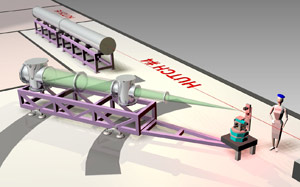
Handy Links
SLAC News Center
SLAC Today
- Subscribe
- Archives: Feb 2006-May 20, 2011
- Archives: May 23, 2011 and later
- Submit Feedback or Story Ideas
- About SLAC Today
SLAC News
Lab News
- Interactions
- Lightsources.org
- ILC NewsLine
- Int'l Science Grid This Week
- Fermilab Today
- Berkeley Lab News
- @brookhaven TODAY
- DOE Pulse
- CERN Courier
- DESY inForm
- US / LHC
SLAC Links
- Emergency
- Safety
- Policy Repository
- Site Entry Form

- Site Maps
- M & O Review
- Computing Status & Calendar
- SLAC Colloquium
- SLACspeak
- SLACspace
- SLAC Logo
- Café Menu
- Flea Market
- Web E-mail
- Marguerite Shuttle
- Discount Commuter Passes
-
Award Reporting Form
- SPIRES
- SciDoc
- Activity Groups
- Library
Stanford
Around the Bay
LUSI Moves Forward
 As construction continues on the experimental halls that will receive the beam from the Linac Coherent Light Source (LCLS), the instruments that will go inside still exist only in the minds and computers of the designers. But in the past few months, those instruments are getting closer to reality.
As construction continues on the experimental halls that will receive the beam from the Linac Coherent Light Source (LCLS), the instruments that will go inside still exist only in the minds and computers of the designers. But in the past few months, those instruments are getting closer to reality.
"Right now things are really picking up," says David Fritz, a scientist on the LCLS Ultrafast Science Instruments (LUSI) project.
Having received approval of Critical Decision-1 from the Department of Energy (DOE) on Sept. 27, 2007, the project is fully staffed and is in the thick of project engineering and design.
"The LCLS is a new type of machine," Fritz says. "Even simple components have to change to be used at LCLS. We're realizing this more and more every day."
The LUSI project will continue through 2012, but sufficient instrumentation will be available by mid-2009 so that LCLS science can begin with LUSI instruments immediately after first light.
The LUSI group is designing three instruments. The Coherent X-ray Imaging Instrument (CXI) will collect structural information on nanometer-sized objects with the goal to one day study individual biological molecules. Although current technologies require that a protein be crystallized before structural analysis, the CXI will not, allowing scientists to study many molecules that have otherwise remained inscrutable.
The X-ray Pump-Probe Instrument (XPP) will use an optical laser to excite a sample that changes upon stimulation with light. The LCLS beam will then probe the changes by collecting and analyzing the scattered x-rays. For example, during photosynthesis chemicals respond to light so quickly that scientists have not been able to decipher the reaction.
The X-ray Correlation Spectroscopy Instrument (XCS) will permit scientists to observe the natural motion or dynamics of matter in equilibrium. These equilibrium motions will be observed on times down to the duration of the LCLS beam, 100 femtoseconds. These studies will be applied to polymers, glasses, superconductors and much more.
The next target for the LUSI team is to establish the baseline costs and the schedule and be ready for the next DOE review and milestone early in 2008.
—Amber Dance, SLAC Today, November 6, 2007
Above image: A cartoon of the planned X-ray Correlation Spectroscopy Instrument, which will be used with the LCLS beam to study polymers, glasses and superconductors. (Image courtesy of Jean-Charles Castagna.)